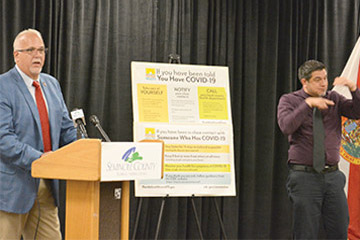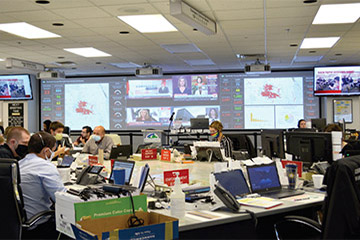Seminole County, Florida Teams With Interpretek Interpreters For Emergency Communications

It was during a 2009 conversation with an American Sign Language (ASL) Interpreter that Emergency Manager Alan S. Harris recognized an opportunity to boost the service level in the Seminole County (Fla.) Office of Emergency Management. The opportunity: to better reach the hundreds in the county’s Deaf and Hard of Hearing (DHH) community by including an ASL interpreter at emergency press conferences.
Following that conversation, he conducted a search for an interpreting services agency to support the initiative, and he selected Interpretek. “Interpretek had the right price, and the best qualifications, too,” Harris said. “They’ve been our partner ever since”—in a program that is now a top priority.
A State of Emergencies
Between hurricanes, pandemics and civil unrest, Seminole County has had its share of emergencies. On Harris’s first day on the job, Aug. 13, 2004, Southwest Florida was hit by the strongest hurricane in its recorded history, Hurricane Charlie. Eight years later his team witnessed the birth of the Black Lives Matter movement in the aftermath of the late Trayvon Martin’s 2012 shooting in Sanford, the county seat. And in 2020, between hurricanes and the Coronavirus pandemic, the office has dedicated 80 percent of its time to emergency response and 20 percent to planning—the opposite of a “normal” year, Harris said. It has bumped the need for ASL interpreters to several times a week, as compared to several a month in a more typical year.

Interpretek has answered the call. “They respond immediately, no matter when we call, and they are always able to fill the need,” Harris said, even in the face of challenges like a relatively quick response window or amid the effects of a hurricane. “After Hurricane Irma, we had a press conference the next day,” he said. “There were trees and electrical lines down, but they got here safely and interpreted for us.”
Most of the interpreting is for press conferences, but it also includes recorded public service announcements (PSA). To drive home the points about the dangers they describe, these PSAs are sometimes done in somewhat hazardous situations as well, such as in front of a live wildfire, but always at a safe distance.
“They respond immediately, no matter when we call, and they are always able to fill the need, even in the face of challenges like a quick response window or amid the effects of a hurricane” said Emergency Manager Alan Harris.
“A Two-Way Street”
The relationship is a two-way street, Harris said, adding, “We’ve learned a lot from them.”
Last year, for example, the office took Interpretek’s advice and began using a Deaf interpreter at press conferences. Using this approach, the hearing interpreter translates into a standard form of American Sign Language to the Deaf interpreter, a native sign language user, who then conveys the information in a very visual way so that a variety of cultural and multilingual members of the Deaf and hard of hearing community can understand the message. “I was skeptical,” Harris said. “But I’ve learned that the DHH community finds it’s easier to communicate with another DHH person. We get a lot of emails and letters and calls from the Deaf community that they really appreciate it.”
Likewise the emergency management office appreciates Interpretek. “They fulfill a crucial function by enabling us to communicate with a part of the community we wouldn’t reach otherwise. Closed captioning is not the same as having someone there you can relate to and see their facial expression and see what’s being said. That’s really critical.”
Especially in an emergency.
Download Case Study